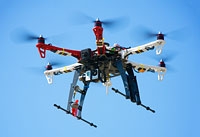Grounded: FAA may kill commercial drone operations by requiring a full pilots’ license
posted Tuesday, November 25, 2014 at 3:16 PM EDT

If you've been looking forward to the time when you can fly what the media loves to call a drone -- most likely, a quadcopter or some other form of multicopter -- legally, shoot aerial photos and videos, and then sell your works... Well, the time may be here to dial back those expectations. In fact, you might want to just drop them altogether, if a report from the Wall Street Journal is to be believed. (The piece can still be read free as of this writing, but will likely be disappearing behind the WSJ paywall shortly. If it does, you can find a similarly pessimistic piece from Time Magazine here, but it's the WSJ who actually broke the story.)
So why the need to dial back those expectations? If the WSJ's sources haven't led them astray, it seems that commercial drone operators may need to hold a pilot's license, something that is both expensive and time-consuming to obtain. It isn't yet clear which license you'll need, but the WSJ article is quite clear that this won't simply be a special license created for unmanned aerial vehicle operators -- instead, it will be a full-blown pilot's license allowing one to operate a manned aircraft.
Assume that license is the private pilot's license, which doesn't allow commercial operations, and you're looking at an investment of something approaching US$10,000, plus three to six months of your time spent studying and flying several times a week, according to a local flying school here in Knoxville, Tennessee. And if the FAA decides to opt for a commercial pilot's license, that expense would be even greater. A quick perusal of Google suggests costs of around US$5,000 more to convert a PPL to a CPL, and possibly a whole lot more.
Will some photographers and videographers be willing to invest the time and money to obtain these licenses, and make their businesses legal? Certainly, because they'll be able to operate a multicopter as an aerial camera platform in places they simply couldn't use a full-blown helicopter for safety reasons. For most, though, that price and effort is going to prove prohibitive, if the WSJ's predictions turn out to be true. While reasoanbly versatile multicopters like DJI's Phantom series are now available for well under US$1,000, you'll have to pay an order of magnitude more to be allowed to use them commercially.
And frankly speaking, as enthusiastic (and non-commercial) multicopter users ourselves, requiring a full pilot's license doesn't make any sense. Sure, there are important things you'll learn in the process of getting your pilot's license that will stand you in good stead even with your feet on the ground, but much of what you'll learn will have zero utility if your only aim is to fly a radio-controlled vehicle, and much of what you'll need to know about safe UAV operations won't be mentioned in the process of getting a manned pilot's license. What's really called for, in our opinion, is a specific, affordable licensing scheme for UAV users, whether commercial or non-commercial. A few hours should be more than enough to lay the groundwork of an understanding as to how UAV flights should be conducted, and why breaking the rules is potentially dangerous.
But we digress, and there are still more rumors from the WSJ as to what the FAA ruling will entail. Importantly, there will not be a lower boundary on what requires a license if flown commercially, according to the WSJ's source. Anything 55 pounds and under will be treated equally as an unmanned aerial device. And all UAV operations will be limited to line-of-sight flight in the daytime hours only, at an altitude of no more than 400 feet. These last requirements are similar to those from a 1980s advisory to enthusiasts operating model aircraft non-commercially, but that was merely an advisory with no legal teeth -- this would be an absolute requirement, and one that would prevent many of the videos we've seen shot from multicopters at night, or well above the tops of skyscrapers.
Of course, all of this so far is so far nothing more than a rumor, albeit one from a reputable source. The identity of those who spoke to the WSJ is unknown, and even if these do turn out to be the rules that the FAA wants to institute, there will be a public comment period in which to air your views. The proposal is expected to come by year's end, and it will be another 1-2 years before they are made final.
What do you think of these rumors? Do you believe that the FAA is going to take such a strong stance against commercial UAV usage, and if so, do you believe that's the right move? Sound off in the comments below.
(Hexacopter thumbnail courtesy of unten44 / Flickr used under a Creative Commons CC BY 2.0 license.)
